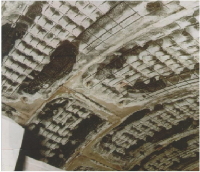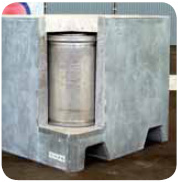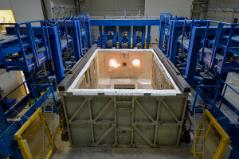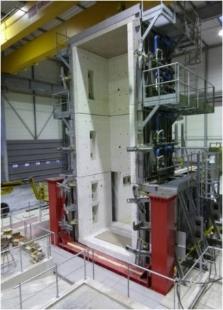ANR project: UCOMP. Ultra-fluid cement composite for the storage of radioactive waste exposed to fire hazards

Context
To store long-lived intermediate-level radioactive waste, reinforced concrete containers will be used. They mainly play a mechanical role in the structural resistance allowing the containers to be transported and stacked. They also participate in limiting the amount of radionuclides transported out of storage (low transfer and retention of certainradioactive elements owing to the chemical properties of the concretes). As part of the Cigéo project (underground storage at
-500 meters of the most radioactive waste), it was necessary to consider a fire scenario in which the function of the containers would not be affected. However, a thermal load as high as this can cause severe cracking and instability phenomena (explosion, spalling, etc.) which can seriously affect the mechanical resistance of the concrete if its formulation is not suitable. It is therefore necessary to develop specific concretes whose mechanical resistance is maintained even after a fire.
Objectives
The objective of the UCOMP project is to design cement materials that can withstand very high temperatures (fire scenario) to manufacture containers for nuclear waste.
For this purpose, the project proposes to use a composite cement material to which are added polypropylene fibers (PP). Effectively, concretes containing organic fibers are already known and used for building tunnels owing to their fire-resistant properties. As the temperature increases, the fibers melt and form a connected porous network in addition to the initial porosity. This porous network evacuates the steam contained in the concrete, which when it is confined exerts pressures that can damage the structure. The UCOMP project therefore proposes to transpose the developments already achieved in civil engineering to the issue of nuclear waste storage. The greatest challenge is to develop a formulation in which fluidity is sufficient to ensure proper implementation.
Storage MA-VL
For this purpose, the UCOMP project will study the formulation of these composite cement matrices using an original global approach combining rheological, mechanical and thermal aspects. As fire resistance and fluidity react in contrasting ways when organic fibers are added (the more are added the better the fire resistance but the poorer the fluidity of the material) (see figures below), the aim of the project is to identify how these two properties can be optimized.
Workflow
The project will last 42 months and will test materials from laboratory scale to full scale.
The first part of the project, carried out at the SIAME and the IFSTTAR, will involve laboratory tests to obtain a formulation for concretes that are optimized in terms of their fluidity when fresh and their behavior at high temperatures (cubes of 20 cm). The second part of the study will involve testing samples at medium scale at the CERIB (small slabs 15 cm thick with a surface area of 1 m²) then at full scale at the CSTB in the Vulcain furnace. Two full-scale fire tests will be performed in this furnace on samples with a geometry very similar to that of the storage containers.
Promethee furnace at the CERIB (horizontal 16-MW furnace with 20 vertical cylinders and 9 horizontal cylinders for testing elements of up to 6 x 4 meters).
Vulcain furnace at the CSTB (13.5-MW vertical furnace for testing elements up to 3 m wide and 9 m high with possible application of a mechanical load).
Expected results
- Innovation
The objective of this project is to acquire new knowledge about concretes containing polypropylene fibers, particularly concerning their rheological properties when fresh and their behavior at high temperatures. Experiments at microscopic scale (tomography, SEM observation, rheometer tests, etc.) will help highlight and understand predominant phenomena. When associated with numerical simulations, the results of the experiments will serve to develop a methodology for optimizing formulations. The innovation of this work lies first in the combined study of the rheology of fresh concrete and its behavior at high temperatures, and second in the association of experiments and numerical simulations.
Besides enhancing our knowledge of phenomena, the UCOMP project will contribute to developing an innovative formulation for a fire-resistant cement material that is easy to place, including for complex shapes.
- Economic impact
In addition to their fire-resistant properties, the materials developed as part of UCOMP will present good workability and should help reduce costs compared to existing materials. Effectively, low concrete fluidity requires the use of additives (superplasticizers) or greater amounts of embodied energy (more labor), both sources of additional expenses.
- Impact for nuclear waste management
In the context of nuclear waste management, the project will contribute to improving the safety of installations. The fire hazards identified for the storage of nuclear waste needs to be taken into account when the containers are designed. The concretes developed as part of this project will meet this requirement and therefore contribute to the safety conditions essential for the Cigéo project.
Application and valorization
These concretes will serve for the storage of nuclear waste, but will also be useful for infrastructures (tunnels, underground parking lots, etc.) and buildings. These types of structures can effectively be exposed to high temperatures during their service life, and the use of concretes with organic fibers likely to protect against spalling is currently limited due to poor workability. The concretes developed as part of the UCOMP project will guarantee resistance during a fire making them easier and faster to repair. On top of this, the quality of the concrete (mechanical characteristics, durability, skin quality, etc.) is directly related to the quality of the placing. Ultra-fluid concrete is easier to place and the related noise pollution can be reduced, particularly concrete vibration, which becomes unnecessary.
Calendar/funding:
Duration: 42 months.
Project kick-off: February 1, 2017.
Total budget of the project: €1.525 M
Incl. financial assistance from the Investment for the future program: €0.543 M
Type of financial assistance: grants with return on investment conditions for the State
Project supported by the ANDRA as part of the Investments for the future “Nuclear of tomorrow” program.
Partnership:
Coordinator: University of Pau and the Adour region
Partners: the CERIB (Concrete industry study and research center), the CSTB (Construction industry scientific and technical center) and the IFSTTAR (French institute of science and technology for transport, development and networks).
Sites:
UPPA – Anglet, CERIB – Épernon, CSTB – Champs-sur-Marne, IFSTTAR – Champs-sur-Marne
Contact:
Hélène Carré, helene.carre@univ-pau.fr
To find out more: link www.andra.fr page IA
SIAME members involved: Hélène Carré (project leader)


